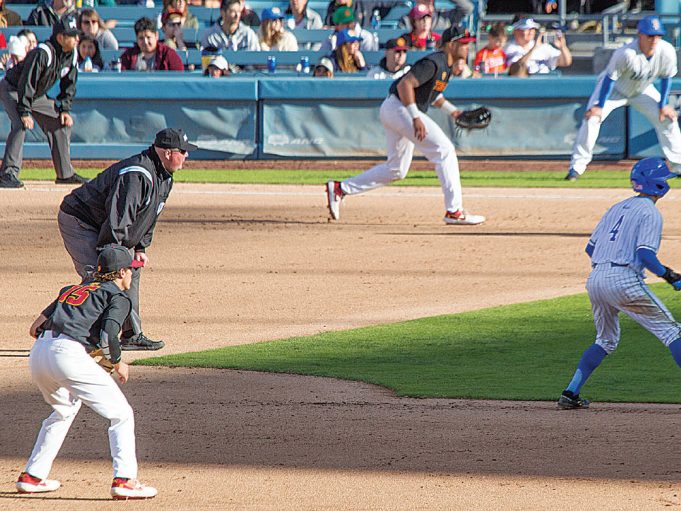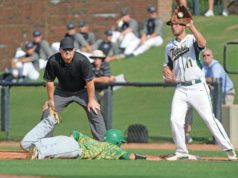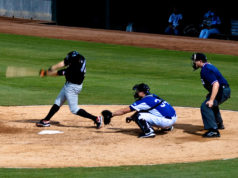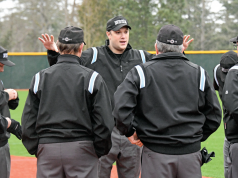If you ever have any doubt what area of the game is going to get you in the most trouble as a baseball umpire, crack open either the NFHS or NCAA rulebook and look up the respective rules for batting, pitching and baserunning.
Batting? A few pages devoted to the proper batting order, a handful of possible infractions
that may occur while one is at-bat and a list of the ways a batter is out.
Pitching? Brief discussions of the legal pitching positions, balks and when a pitcher must be removed from the game.
Baserunning? Yikes.
Yes, baseball would be a simple game if the players only needed to pitch the ball, hit the ball and throw the ball. However, they are legally required to run around the bases, and that creates all manner of havoc for umpires. A lot can happen in 90 feet to get baserunners in trouble and put umpires in the crosshairs of knowing what is and is not legal baserunning behavior.
For the purposes of this article, we are going to dive into one small but important element of the baserunning rules — what happens when one baserunner passes another on basepaths? The rule citation in each of the NFHS, NCAA and pro codes is simple enough, but as with many situations that take place on a baseball field, the proper application is anything but.
Let’s start with those actual rules. In NFHS play, any runner is out when he passes an unobstructed preceding runner before such runner is out, including awarded bases (8-4-2m). In NCAA play, a runner is out when the individual passes an unobstructed preceding runner before such runner is out. The ball is live (8-5m). According to pro rules, any runner, including the batter-runner, is out when he passes a preceding runner before such runner is out (5.09b9).
Like we said, simple right? Well, let’s start with the fact the NCAA rule, unlike the other two, specifically mentions the ball remains live. This is an important facet of these plays, and some additional digging into the respective rulebooks is needed to reveal that this also applies in NFHS, which states the ball becomes dead when baserunning penalties are imposed (5-1-3). Therefore, the ball remains live when the infraction occurs. While pro rules do not specifically cover the point, various interpretations indicate the ball also remains live at that level.
Now, let’s dig into some of these situations to show the nuances involved when one baserunner illegally passes another.
Play 1: With R1 on first base and one out, B3 hits a fly ball deep to left field. R1, unsure whether the ball will be caught, runs halfway toward second base and stops. B3, running hard out of the box, rounds first base and continues past R1. After B3 passes R1, the ball lands in fair territory. Ruling 1: B3 is out for passing R1. The ball remains live and R1 may advance. Once all playing action ends, the umpires will likely need to call time and inform B3 he is out.
Play 2: With R2 on second base, R1 on first base and one out, B4 hits a fly ball deep to right field. R1, believing the ball will fall, sprints around second base and passes R2. The ball is (a) caught by F9 in fair territory, (b) caught by F9 in foul territory or (c) lands in fair territory. Ruling 2: In both (a) and (b), R1 is out for passing R2 and B4 is out because the ball was caught, resulting in an ending-inning double play. In (c), R1 is out for passing R2 and the ball remains live.
Play 3: R3 is on third base and R2 is on second base with one out. B4 hits a ground ball to shortstop and R3 breaks for home. R2 also breaks for third. R3 gets in a rundown and is returning toward third base, where R2 is standing on the base. R3 passes the base toward left field and is standing two steps off the bag when F5 (a) tags R2, or (b) tags R3. Ruling 3: R3 is entitled to third base because he is not forced. However, once R3 runs backward past the base, R2 is now guilty of passing R3 and is out on the play. Therefore, in (a), the tag of R2 is irrelevant. In (b), R3 is also out as a result of being tagged while off the base, resulting in an inning-ending double play.
Play 4: With the bases loaded and one out, B5 hits a long fly ball to right-center field. R2, unsure of whether the ball will be caught, is only a few steps off second base when R1 passes him. The ball is (a) caught, or (b) falls safely to the ground. Ruling 4: In (a), R1 is out as soon as he passes R2 and B5 is out on the catch resulting in an inning-ending double play. In (b), R1 is out, but the ball remains live and the other runners may advance.
Play 5: With the bases loaded and two outs, B6 hits a long fly ball to right-center field. R2, unsure of the number of outs, tags up. R1 passes R2 (a) before, or (b) after R3 has already crossed the plate. The ball lands safely in fair territory. Ruling 5: This is a timing play. In (a), because R1 illegally passed R2 for the third out of the inning before R3 scored, the run does not count. In (b), the illegal passing is still the third out, but the run scores.
Play 6: With the bases loaded and two outs, B6 hits a long fly ball toward right-center field. R1, unsure of the number of outs, is only a few feet off first base when B6 passes him. The ball clears the fence for a home run. Ruling 6: B6 is out for passing R1 for the third out of the inning. If R3 and/or R2 cross the plate before the passing, their runs score as the result of this being a timing play. If not, no runs score on the play.
Scott Tittrington is an associate editor at Referee. He umpires college and high school baseball, and officiates college and high school basketball and high school football. *
What's Your Call? Leave a Comment:
Note: This article is archival in nature. Rules, interpretations, mechanics, philosophies and other information may or may not be correct for the current year.
This article is the copyright of ©Referee Enterprises, Inc., and may not be republished in whole or in part online, in print or in any capacity without expressed written permission from Referee. The article is made available for educational use by individuals.


















